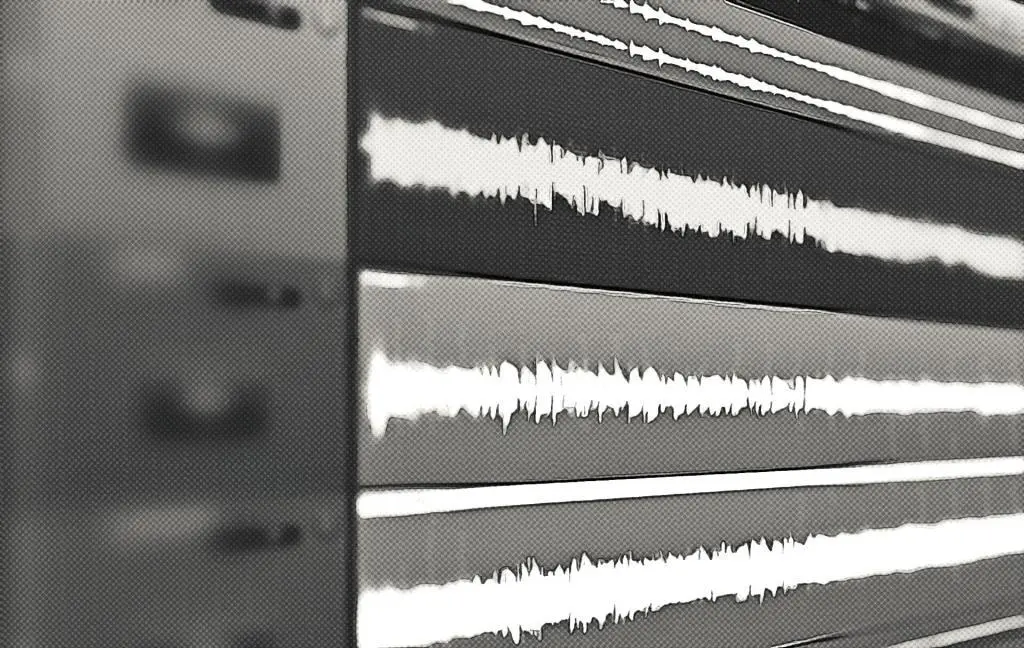Music production is a complex process that requires a great deal of skill and expertise. One of the key tools used in this process is the concept of stems.
Stems in music production refer to individual tracks or sections of a song that have been separated out and exported individually.
For example, a stem of a song might include just the vocals, or just the drums. This allows for greater flexibility in the mixing and mastering process, as each stem can be individually adjusted and processed.

What are Stems in Music: Table of Contents
Music production is a complex process that requires a great deal of skill and expertise. One of the key tools used in this process is the concept of stems.
In the modern music production landscape, music stems have become an essential tool for both producers and engineers. Their importance cannot be overstated in the creative process.
Music stems can be defined as individual stereo tracks that contain pre-mixed groups of instruments, vocals, or other elements of a song. They are very important in providing flexibility and ease of use when working on a track, especially during the mixing and mastering stages of production.
Understanding the role of music stems in the creative process is essential for any producer or engineer looking to take their work to the next level.
Understanding Music Stems
Music stems are individual audio tracks that are grouped together in a stereo file. These groups can include vocals, drums, guitar, bass, keyboards, and other instrument groups.
They are created by mixing a selection of tracks in a Digital Audio Workstation (DAW) and exporting them as separate stereo files. The purpose of using stems is to provide flexibility in the creative process, allowing producers and engineers to manipulate individual elements of a song during mixing and mastering.

Comparison of Multitracks and Stems in Music Production
While both multitracks and stems are important in music production, they serve different purposes.
Multitracks consist of all the individual elements of a recording, with each track dedicated to a specific instrument or sound. They offer complete control over each element of a mix and allow for extensive editing and manipulation.
On the other hand, stems are stereo mixes of groups of tracks, providing a simpler way to manipulate a mix. Stems offer a compromise between the control of multitracks and the simplicity of stereo mixes.
Overview of Different Types of Stems in Music Production
When creating music, different elements such as vocals, instruments, and percussion are often recorded separately, and then combined to create the final mix. These individual tracks can be grouped together and bounced down to create stems, which are essentially submixes of the individual tracks. Here are some common types of stems in music production:
- Lead Vocal Stem: This stem includes the lead vocal track(s) of a song. Lead vocals are usually the most important element in a song, and mixing them well is crucial to the overall sound.
- Backing Vocal Stem: This stem includes any additional vocal tracks in a song, such as harmonies or ad-libs. Backing vocals can add depth and complexity to a track, and can also be used to fill out the mix.
- Instrument Stem: This stem includes any instrument tracks in a song, such as guitar, bass, piano, or synth. These stems are important for creating the overall musical texture and groove of the song.
- Percussion Stem: This stem includes any percussion tracks in a song, such as drums, shakers, or tambourines. Percussion is important for creating rhythm and energy in a song, and can also be used to add interest and variation to the mix.
Explanation of Each Type of Stem and Their Purpose in the Mixing Process
Each type of stem has a specific purpose in the mixing process, and can be used to create a more polished and cohesive final mix.

Here are some examples:
- Lead Vocal Stem: The lead vocal stem is usually the most important element in a song, and should be mixed to sit prominently in the mix. It’s important to ensure that the lead vocals are clear and intelligible, while also sitting well with the rest of the mix.
- Backing Vocal Stem: The backing vocal stem is often used to create depth and interest in a song. These stems can be panned differently than the lead vocal stem, and can also be processed with effects like reverb or delay to create a sense of space.
- Instrument Stem: The instrument stems are important for creating the overall musical texture of a song. These stems can be used to balance the levels of different instruments in the mix, as well as to create separation and clarity between each instrument.
- Percussion Stem: The percussion stem is important for creating rhythm and energy in a song. These stems can be used to add variation and interest to the mix, as well as to create a sense of groove and movement.
Preparing Music Stems
Best practices for preparing stems for mixing
- Make sure all stems are consolidated to the same starting point
- Export stems in the same file format and sample rate
- Disable any effects or processing on the stems
- Check for any clicks, pops, or clipping in the stems
- Export stems at a consistent level to prevent volume imbalances during mixing
Tips for organizing and labeling stems
- Use clear and concise names for each stem
- Group similar stems together in folders
- Use color coding to make it easier to identify stems
- Label the stems with the song title, tempo, and key
Importance of consistency in volume levels and panning
- Ensure that each stem has a consistent volume level throughout the song
- Use panning to create a balanced and spacious mix
- Avoid extreme panning that could cause issues during the mastering process.
Mixing with Music Stems
Overview of the mixing process with stems
Mixing with stems involves balancing the levels and frequencies of individual tracks to create a cohesive and balanced mix. It’s important to start by listening to each stem and identifying any issues or areas that need attention.
Techniques for balancing levels and EQing stems
To balance levels, start by setting the relative volumes of each stem, taking care not to create any frequency clashes. Use EQ to shape the frequency spectrum of each stem, paying attention to the mid-range and low-end frequencies, which can easily become cluttered.
Tips for creating depth and space in a mix using stems
Using panning and reverb can help to create a sense of depth and space in a mix. Panning can be used to place individual stems within the stereo field, while reverb can be used to create a sense of space and distance. It’s important to use these tools sparingly and with intention, as overuse can result in a muddy or washed-out mix.
Mastering with Music Stems
Explanation of Stem Mastering and its Benefits
Once the mixing stage is complete, the next step is mastering, where the final touches are added to the mix to ensure it sounds polished and cohesive. Stem mastering is a technique that allows the mastering engineer to work with individual stem groups rather than the entire mix. This approach gives the mastering engineer greater control over the final sound and allows for more precise adjustments.
Stem mastering also provides a solution when the mix is not quite perfect, as the mastering engineer can work on individual stem groups to address issues rather than trying to fix the entire mix. This technique is especially useful for large projects with many elements or complex arrangements.
Techniques for Stem Mastering
When mastering with music stems, the same mastering techniques are used, but the difference is that they are applied to each stem group individually. Some of the most common techniques used in stem mastering include:
- Limiting: Limiting is used to control the peak levels of the mix and prevent distortion. When mastering with stems, limiting can be applied to individual stem groups, allowing the engineer to achieve greater control over the final sound.
- Compression: Compression is used to even out the dynamic range of the mix and create a more consistent overall sound. Again, when mastering with stems, compression can be applied to individual stem groups, allowing for more precise control over the final sound.
- EQ: Equalization is used to balance the frequency spectrum of the mix and address any tonal imbalances. When mastering with stems, EQ can be applied to individual stem groups, allowing for more targeted adjustments.
Tips for Achieving a Polished and Cohesive Sound with Stem Mastering
- Use consistent settings: When mastering with stems, it’s important to use consistent settings for each stem group to achieve a cohesive sound. This includes consistent EQ and compression settings.
- Match levels: It’s also important to match the levels of each stem group to ensure they are balanced and work well together. This can be achieved through careful volume adjustments and gain staging.
- Reference your mix: When mastering with stems, it’s important to reference the final mix to ensure that any adjustments made to the stem groups are working well together and achieving the desired result.
- Take breaks: Stem mastering can be a time-consuming process, so it’s important to take regular breaks to rest your ears and ensure you are making objective decisions.
By following these tips and techniques, you can achieve a polished and cohesive sound when mastering with music stems.
Mistakes When Using Music Stems
Using low-quality stems is one of the most common mistakes that producers make. Low-quality stems, such as those recorded at low bit rates or in noisy environments, can negatively impact the overall sound of the mix. It is always best to use high-quality stems whenever possible to ensure the final mix is of the highest quality.
Another common mistake is not properly preparing stems before mixing. Improperly prepared stems, such as those with inconsistent levels, unedited silence, or no clear labeling, can cause issues during mixing and mastering. Taking the time to properly label, edit, and prepare stems can save time and headaches during the mixing process.
Overloading stems with too much processing is also a common mistake. While processing can be used to enhance a stem, overuse can result in a mix that sounds too processed and artificial. It is important to use processing sparingly and with intention, always keeping in mind the overall sound of the mix.
Not checking for phase issues between stems is another common mistake. Phase issues, such as cancellation and other unwanted artifacts, can occur when two or more stems are out of phase with each other. It is important to check for phase issues before mixing and address them if necessary to ensure a clean and polished mix.
Finally, neglecting to level-match stems before mixing can lead to an unprofessional and uneven mix. Each stem should be level-matched to ensure that the mix is balanced and cohesive.
The Benefits of Using Stems in Music Production
One of the main benefits of using stems in music production is that it allows the engineer or producer to have more control over the final mix. For example, if the drums are too loud in the mix, the engineer can simply adjust the volume of the drum stem, rather than having to adjust the volume of the entire mix. This can also make it easier to make changes to a song later on, such as adding or removing elements.
Another benefit of using stems is that it allows for greater collaboration among team members. For example, if a producer wants to work on a song with a vocalist, they can export the vocal stem and send it to the vocalist for them to work on. This allows for a more efficient workflow and can save a lot of time in the long run.
Stems can also be useful when it comes to mastering the song. A mastering engineer can use the stems to EQ, compress and add effects to different elements of the song independently, resulting in a more polished and professional sounding final mix.
Using stems in music production also allows for more flexibility in the post-production process. For example, if a certain element of a song is not working well, it can be easily replaced or removed without affecting the rest of the mix.
FAQs about “What are Stems in Music?”

Here, you can find brief responses to the most common FAQs about stems in music. As we continue to receive questions from our users, we will make sure to expand and update this section to ensure that it remains a comprehensive resource for understanding the concept of stems in music.
What are Stems in Music? (Shortest Definition)
Stems in music are individual tracks or elements of a composition that can be separated and manipulated independently.
How do I make stems?
To create stems in music production, you typically follow these steps:
1. Start with a multi-track recording: A multi-track recording is a recording that has been captured with each element of the composition recorded separately onto its own track. This can be achieved using a Digital Audio Workstation (DAW) or a multi-track recorder during the recording process.
2. Identify the tracks to be separated: Determine which tracks you want to separate into individual stems. This could include tracks for vocals, drums, bass, guitars, keyboards, and other elements of the composition.
3. Solo and bounce each track: Solo each track one by one, muting all other tracks, and then bounce/export/render each track as an individual audio file. This process is usually done within your DAW and involves exporting each track as a separate audio file, typically in a lossless format like WAV or AIFF.
4. Label and organize the stems: Once you have exported each track as a separate audio file, label and organize them in a way that makes sense for your workflow. This could include naming the files with descriptive labels and organizing them into folders for easy access.
5. Import stems into a new project: Create a new project in your DAW or audio editing software and import the stems as individual tracks. This will allow you to manipulate and mix the stems independently to create different versions or arrangements of the composition.
6. Further editing and mixing: With the stems imported, you can now further edit and mix them as needed. This could include adjusting levels, applying effects, adding automation, and making other changes to achieve the desired sound.
7. Save and export the final mix: Once you are satisfied with your edits and mix, save your project and export the final mix as a stereo audio file or in a format suitable for your intended use, such as a WAV or MP3 file.
How many stems are in a song?
The number of stems in a song can vary greatly depending on the complexity and arrangement of the music. In general, a stem refers to an individual audio track that represents a specific element of the composition, such as vocals, drums, bass, guitars, keyboards, and other elements. Therefore, the number of stems in a song would typically correspond to the number of distinct elements or tracks that make up the composition.
A simple acoustic song with just a vocalist and a single acoustic guitar may have as few as two stems: one for the vocals and one for the guitar. On the other hand, a complex modern pop song with multiple vocal harmonies, a full band with drums, bass, multiple guitars, keyboards, and additional electronic elements could have dozens of stems, potentially exceeding 20 or more.
In some cases, stems may be further divided into sub-stems, such as separate tracks for different sections of a drum kit or individual tracks for each backing vocal harmony. This can further increase the number of stems in a song.
It’s worth noting that the decision to create stems and the number of stems generated can be determined by the music producer or engineer based on their creative vision, production approach, and technical requirements. Stems can be used for various purposes, such as remixing, re-arranging, or for live performances, and the number of stems chosen may depend on the intended use and desired level of control over the individual elements of the music.
What are stems vs tracks?
In general, a “track” refers to an individual audio recording or element of a composition, such as a vocal track, a guitar track, a drum track, etc. These tracks are usually recorded separately during the recording process and then mixed together to create the final mix of the song. Tracks are typically represented as separate audio files or channels in a digital audio workstation (DAW) or other recording software.
On the other hand, “stems” typically refer to groups of tracks that have been combined and bounced down to a single audio file, representing a submix of related elements of the song. Stems are usually created during the mixing process, where multiple tracks are combined and processed together to create a cohesive mix. Stems are often organized by instrument groups, such as vocal stems, drum stems, bass stems, guitar stems, etc., and they can be used for various purposes, such as remixing, re-arranging, or for live performances.
Where can I find stems for songs?
Stems for songs can be found from various sources, depending on the specific song and the intended use of the stems. Here are a few places where you may be able to find stems for songs:
1. Official stems releases: Some artists, record labels, or music producers may officially release stems for their songs, either for promotional purposes or for remix competitions. These stems are usually made available through official websites, online platforms, or other authorized channels. You may need to search for the specific artist or song you’re interested in and check if they have released any stems officially.
2. Remix contests: Many artists or record labels organize remix contests, where they provide stems of their songs to producers and musicians to remix. These contests are often hosted on official websites, social media platforms, or music production communities. Participating in a remix contest can be a great way to access stems for a song and showcase your remixing skills.
3. Online stem databases: Some websites or online platforms specialize in hosting and providing stems for songs. These websites may offer stems for various genres, artists, or songs for a fee or for free. Examples of such websites include Splice, Blend.io, and stems-music.com, among others.
4. Collaborating with other musicians or producers: If you’re working with other musicians or producers on a project, they may be able to provide you with stems of the songs they have worked on. Collaborating with other musicians or producers can be a good way to access stems for songs and create new versions or remixes.
5. DIY extraction: In some cases, you may be able to extract stems from a song yourself, using audio separation techniques or software tools. Some advanced audio editing software or plugins may have features that allow you to isolate or extract specific elements from a song, such as vocals, drums, or other instruments. However, the results may vary depending on the quality of the original recording and the complexity of the song.

